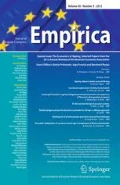Abstract
The public debate about inequality has generated a sense of gloom and doom—that high levels of inequality are inevitable and that little can be done. The aim of this paper is to inject a more optimistic note. I argue that there have been periods in the past when income inequality was reduced and we can learn from these, that the textbook story of the causes of rising wage inequality—globalisation and technological change—has a more optimistic interpretation; and that, whereas wages are a major part of household incomes, but there are other important determinants where it is possible to take action to reduce inequality. The paper ends by outlining four “old” measures to reduce inequality, based on the lessons from the post-war decades in Europe, and four “new” measures suggested by the analysis of today’s economics of inequality.



Similar content being viewed by others
Notes
A gross income of Y becomes a net income of (1 − t)Y + A, where t is the tax rate and A is the benefit paid to everyone (this can be thought of as the value of the personal tax allowance). Since A is the same for all, the Gini for disposable income is (1 − t) times the Gini for market income (Y) divided by the ratio of average disposable income to average market income. Then, if government spending on goods and services (health, education, defence, etc.) absorbs 20 % of tax revenue, the latter ratio is equal to 80 %. Suppose further that the Gini coefficient of market incomes is 50 %. The reduction in the Gini for disposable income from an increase ∆t in the tax rate is then 0.5 times ∆t divided by 0.8.
References
Atkinson AB (1997) Bringing income distribution in from the cold. Econ J 107:297–321
Atkinson AB (2008) The changing distribution of earnings in OECD countries. Oxford University Press, Oxford
Atkinson AB (2015) Inequality: What can be done? Harvard University Press, Cambridge
Atkinson AB, Harrison AJ (1978) Distribution of personal wealth in Britain. Cambridge University Press, Cambridge
Atkinson AB, Morelli S (2014) Chartbook of economic inequality. http://www.chartbookofeconomicinequality.com/
Atkinson AB, Søgaard J (forthcoming) The long run history of income inequality in Denmark. Scand J Econ
Grabka MM, Goebel J, Schupp J (2013) Has income inequality spiked in Germany? In: Rahmann U, Schupp J (eds) SOEP wave report 2012. DIW, Berlin, pp 57–68
Hartog J, Vriend N (1989) Post-war international labour mobility: The Netherlands. In: Gordon I, Thirlwall AP (eds) European factor mobility. Macmillan, London
Hauser R (1999) Personelle Primär- und Sekundärverteilung der Einkommen unter dem Einfluss sich ändernder wirtschaftlicher und sozialpolitischer Rahmenbedingungen. Allg Stat Achiv 83:88–110
Heidensohn K (1969) Labour’s share in national income. A constant? Manch School 37:295–321
IMF (2007) Spillovers and cycles in the global Economy. In: World economic outlook, April, IMF, Washington, DC
IMF (2014) Recovery strengthens, remains uneven. In: World Economic Outlook, April, IMF, Washington, DC
Meade JE (1964) Efficiency, equality and the ownership of property. Allen and Unwin, London
OECD (2011) Divided we stand: why inequality keeps rising. OECD, Paris
OECD (2012) Employment outlook 2012. OECD, Paris
ONS (2011) The effect of taxes and benefits on income inequality, 1980–2009/10. ONS, London
Paine T (1797) Agrarian justice. U.S. Social Security Administration under the heading of “Social Insurance History”. http://www.socialsecurity.gov/history/paine4.html
Piketty T (2011) On the long-run evolution of inheritance: France 1800–2050. Quart J Econ 126:1071–1131
Piketty T (2014) Capital in the twenty-first century. Harvard University Press, Cambridge
Roine J, Waldenström D (2015) Long run trends in the distribution of income and wealth. In: Atkinson AB, Bourguignon F (eds) Handbook of income distribution, vol 2. Elsevier, Amsterdam, pp 469–592
Schumpeter JA (1991) The economics and sociology of capitalism. In: Swedberg R (ed) The economics and sociology of capitalism. Princeton University Press, Princeton
Sen A (2009) The idea of justice. Allen Lane, London
Stiglitz JE (1969) Distribution of income and wealth among individuals. Econometrica 37:382–397
Summers L (2013) Economic possibilities for our children. NBER reporter, no. 4
Author information
Authors and Affiliations
Corresponding author
Additional information
A (considerably) revised version of a plenary lecture given at the Nationalökonomische Gesellschaft/Austrian Economic Association Annual Meeting in Vienna, May 2014. I am most grateful to Wilfried Altzinger and his colleagues for the invitation and for their warm hospitality. The paper is based on research carried out in the Inequality Group that forms part of the EMoD programme supported by INET at the Oxford Martin School. It draws on joint recent work with Salvatore Morelli on the Chartbook of Economic Inequality and with Facundo Alvaredo on the World Top Incomes Database.
Rights and permissions
About this article
Cite this article
Atkinson, A.B. Can we reduce income inequality in OECD countries?. Empirica 42, 211–223 (2015). https://doi.org/10.1007/s10663-015-9288-0
Published:
Issue Date:
DOI: https://doi.org/10.1007/s10663-015-9288-0




